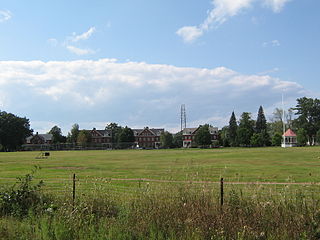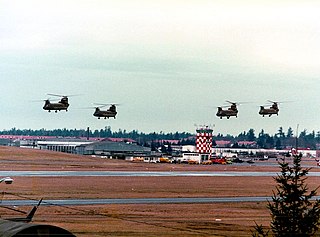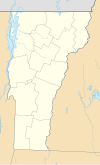
Fort Sill is a United States Army post north of Lawton, Oklahoma, about 85 miles (137 km) southwest of Oklahoma City. It covers almost 94,000 acres (38,000 ha).

Fort Ethan Allen was a United States Army installation in Vermont, named for American Revolutionary War figure Ethan Allen. Established as a cavalry post in 1894 and closed in 1944, today it is the center of a designated national historic district straddling the town line between Colchester and Essex. Locally, it is known simply as "The Fort", and now houses a Vermont National Guard installation a variety of businesses, academic institutions, and residential areas.

Gray Army Airfield, also known as Gray AAF, is a military airfield located within Joint Base Lewis–McChord near Tacoma, in Pierce County, Washington, United States.

The Vermont National Guard is composed of the Vermont Army National Guard and the Vermont Air National Guard. Together, they are collectively known as the Green Mountain Boys. Both units use the original Revolutionary War-era Flag of the Green Mountain Boys as their banner. In 2009, they had 2,600 members.

Sherman Army Airfield is a joint use civilian-military airport located at Fort Leavenworth, Kansas, in Leavenworth County, Kansas. The airport is located on the United States Army post, but the city of Leavenworth, Kansas, has an agreement providing for civilian use at all times without prior notice or permission. Civilian use of the airfield far exceeds military use 93% to 7% as of the end of 2019.

The 15th Attack Squadron is a United States Air Force unit assigned to the 432d Wing, 732nd Operations Group at Creech Air Force Base near Indian Springs, Nevada. It flies the General Atomics MQ-9 Reaper remotely piloted aircraft.

Ellington Field Joint Reserve Base is a joint installation shared by various active component and reserve component military units, as well as aircraft flight operations of the National Aeronautics and Space Administration (NASA) under the aegis of the nearby Johnson Space Center. The host wing for the installation is the Texas Air National Guard's 147th Attack Wing. Opened in 1917, Ellington Field was one of thirty-two Air Service training camps established after the United States entry into World War I. It is named for First Lieutenant Eric Ellington, a U.S. Army aviator who was killed in a plane crash in San Diego, California in 1913.

Marshall Army Airfield (MAAF) is a military airfield located on Fort Riley, Kansas, United States. It was opened in 1921. The primary mission of MAAF is to provide fully integrated fixed base helicopter operations for the Combat Aviation Brigade, 1st Infantry Division.

Dodd Army Airfield was an airfield located within the current boundaries of Fort Sam Houston in San Antonio, Texas. Dodd Field includes the area bounded on the north by Rittiman Road, on the west by Harry Wurzbach Memorial Highway, on the south by Winans Road and on the east by the Fort Sam Houston Reservation boundary.

The 118th Airlift Squadron is a unit of the Connecticut Air National Guard 103d Airlift Wing stationed at Bradley Air National Guard Base, Windsor Locks, Connecticut. The 118th is equipped with the C-130H.

The 106th Air Refueling Squadron is a unit of the Alabama Air National Guard 117th Air Refueling Wing. It is assigned to Birmingham Air National Guard Base, Alabama and is equipped with the KC-135R Stratotanker aircraft.

The 110th Bomb Squadron is a unit of the Missouri Air National Guard 131st Bomb Wing located at Whiteman Air Force Base, Knob Noster, Missouri. The 110th is equipped with the Northrop Grumman B-2 Spirit.

The 134th Fighter Squadron, nicknamed the Green Mountain Boys, is a unit of the Vermont Air National Guard 158th Fighter Wing located at Burlington Air National Guard Base, Burlington, Vermont. From 1986 to 2019, the 134th FS were equipped with the General Dynamics F-16C/D Fighting Falcon Block 30. The last F-16s departed Burlington on 6 April 2019 in preparation for the Lockheed Martin F-35A Lightning II which arrived on 19 September 2019. Since becoming an F-35A unit, the Green Mountain Boys are tasked with carrying out the Suppression of Enemy Air Defenses (SEAD).

The 436th Training Squadron is a non-flying training squadron of the United States Air Force. The 436th Training Squadron, located at Dyess Air Force Base, Texas, is a geographically separated unit within Air Combat Command’s 552nd Air Control Wing, at Tinker Air Force Base, Oklahoma.

The 394th Combat Training Squadron was a United States Air Force unit assigned to the 509th Operations Group until inactivated on 13 April 2018. It was stationed at Whiteman Air Force Base, Missouri. The mission of the squadron was to train Northrop Grumman B-2 Spirit aircrews, a mission now executed by the 13th Bomb Squadron. The 394th is the fourth oldest squadron in the United States Air Force. Its history dated to 5 May 1917 as the 4th Aero Squadron.

Henry Post Army Airfield is a military use airport located at Fort Sill in Comanche County, Oklahoma, United States. This military airport is owned by United States Army. Established as Post Field in 1917, it was one of thirty-two Air Service training camps established after the United States entry into World War I in April 1917.

The 22d Intelligence Squadron is a non-flying squadron of the United States Air Force. It is assigned to the 691st Intelligence, Surveillance and Reconnaissance Group, Fort George G. Meade, Maryland.

The history of the Arkansas National Guard and World War II begins with the reorganization following World War I. The State first reorganized a provision unit, the 5th Arkansas, in order to provide a force to deal with domestic situations. As the Defense Department slowly implemented the massive changes and expansions outlined National Defense Act of 1916, the Arkansas National Guard was allowed to reorganize its war time units, including the 153rd Infantry Regiment, the 141st Machine Gun Battalion, and the 142nd Field Artillery. The Guard acquired its first permanent facilities and additional training during its annual encampments. During World War II, the entire Arkansas National Guard was activated and units saw duty in the Pacific and European theaters of conflict.

The 86th Field Artillery Regiment is a inactive parent field artillery regiment of the United States Army, last represented in the Vermont Army National Guard by the 1st Battalion, 86th Field Artillery Regiment. Perpetuating the Vermont Light Artillery Batteries of the American Civil War and subsequent Vermont artillery units, the regiment was organized following World War II as the 206th Field Artillery Battalion in the Vermont National Guard. The 206th saw active service in Germany with the 43rd Infantry Division during the Korean War, and became the 124th Artillery, a Combat Arms Regimental System parent regiment, in 1959. Represented by the 1st Howitzer Battalion, 124th Artillery, the regiment was renumbered as the 86th Artillery in 1964 when the 1st Battalion became the brigade artillery battalion of the 86th Armored Brigade. The 1st Battalion served in that role with the brigade for much of the rest of its existence.
The First Corps Area was a Corps area of the United States Army. It replaced the Northeastern Department, and was headquartered at South Boston Army Base, Massachusetts. The organization included Army units and facilities in Maine, Massachusetts, New Hampshire, Rhode Island, Vermont, and Connecticut. It was responsible for the mobilization, and administration of the First United States Army (1936–38); the Fourth Army, I Army Corps with 9th, 26th, and 43d Divisions; XI Corps, constituted 29 July 1921, with the 76th, 94th, and 97th Division; coast defense units of the First Coast Artillery District, some units of the GHQ Reserve, and the Zone of the Interior support units of the First Corps Area Service Command. First Corps Area was redesignated First CASC in May 1941.




















